JIGGING IN THE JUNGLE
Words & Images by Mat Cranswick
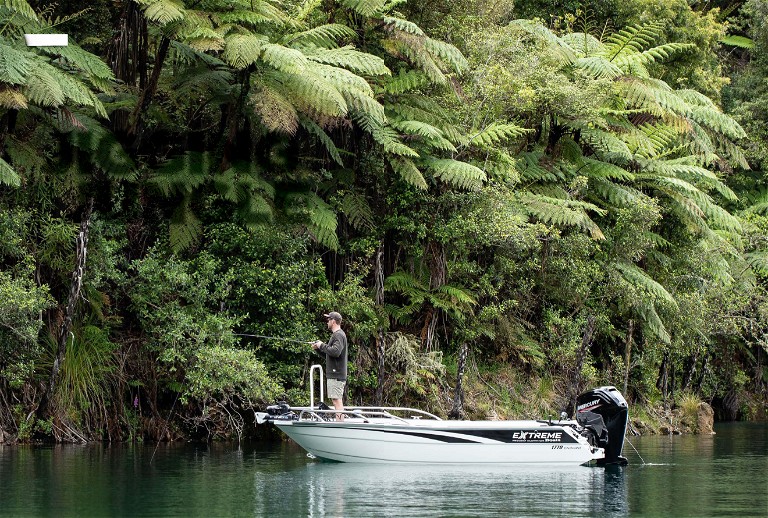

“ Living in the Bay of Plenty, I am fortunate to have some very productive lakes nearby with Lake Rotoiti, Rotoma, Tarawera and Okataina offering fantastic jigging opportunities. ”
Here in New Zealand, we are fortunate to have an abundance of pristine freshwater lakes surrounded by thick, green native bush, which are often stocked with good numbers of rainbow trout. There are many methods to try to fool the crafty rainbows that inhabit these waters, and one method that has gained popularity over the past years due to its success in putting a bend in anglers’ rods is jigging. Jigging for trout has evolved from tying a single small metal jig on some light trace to a rig typically consisting of a small sinker down the bottom and three flies tied on droppers above, and it can be lethally effective at certain times of the year.
Where
Living in the Bay of Plenty, I am fortunate to have some very productive lakes nearby with Lake Rotoiti, Rotoma, Tarawera and Okataina offering fantastic jigging opportunities. The one thing in common with having a successful trip on all these lakes is understanding how to find what the trout are feeding on. Typically on these lakes the main food source is a small fish called smelt which are found throughout New Zealand. They are usually around 40-60mm in length and come in various shades of silver.
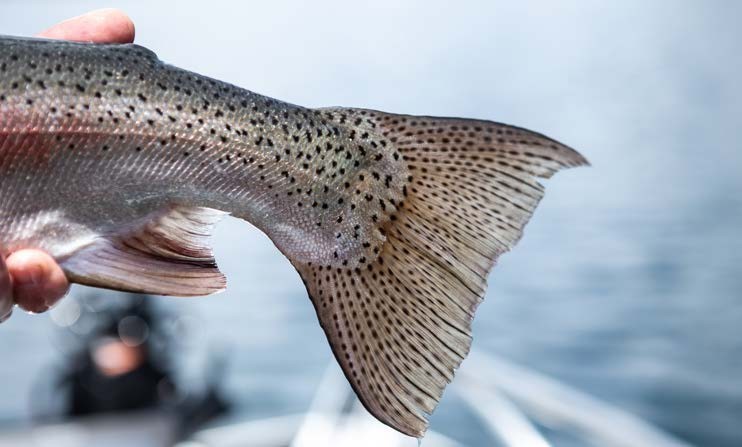
Over the summer months the sun warms the surface layer of these lakes. Where this warm surface layer meets the cooler water deeper down, a thermocline is created. The thermocline creates an invisible wall which for a few months of the year holds large schools of smelt. This convergence of water temperatures creates a natural highway and easy pickings for the hungry rainbows ready to pile on condition for the winter spawn ahead.
The thermocline will vary in depth throughout the summer months but often sits around 20 meters deep. Often the secret to a successful jigging session is not what depth you are fishing in, but rather what depth your flies are in. For example, if your fishfinder is showing a thick band of bait 20 meters down and you are in 50 meters, you will want to keep your flies 20 meters down – not on the bottom. The thermocline depth is often the same across the entire lake, and if you were to move to another part of the lake that is 20 meters deep that bait layer will be on the bottom and that is where you will want your flies.
I have found the shallower parts of the lakes will fish well early in the season as they warm faster, therefore I concentrate on those areas until mid-summer when the lakes warm in entirety. The next secret to success is having a good fishfinder and trusting it, as a good fishfinder will differentiate the trout from the smelt schools. On some days they will be just above the smelt and on others right amongst it – when you have a band of smelt 15 meters thick this can make a huge difference. Trusting in your sounder will also give you the ability to quickly drop or wind up to a marked trout below, meaning your flies are in the right place at the right time. On our Extreme 545 Sport Fisher we run a Raymarine Axiom Plus that often shows smelt schools as a yellow scatter layer and trout as a red arch. During many of the best jigging sessions, we have had the yellow scatter layer ending up quite red due to the smelt huddling in tighter as the trout work together – much like tuna or dolphins herding up anchovies. If you do not have a fishfinder on your boat, the other place to target trout doing the same thing is up against steep rocky faces that fall into the lake or steep drop-offs as these will also act like walls for trout to herd smelt against.
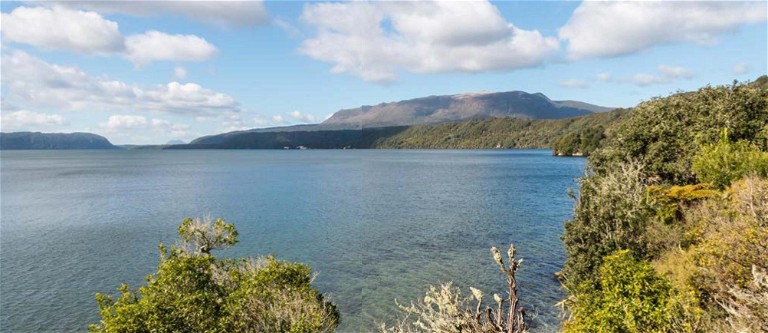
When
Jigging will work throughout the year, but by far the most productive period would be from January through until the end of March when the summer sun has created a solid thermocline and the smelt become concentrated. The other great thing about jigging for trout is you do not have to be up super early or late to experience a good bite, and they can bite well any time of the day no matter the weather. It is just a matter of being there when the switch turns on and they decide to feed. This can be frustrating at times, however, and there have been plenty of occasions when we have sat in the same spot for hours marking good bait and fish without a bite, until suddenly you are getting hit on every drop without changing a thing. My theory on this is that there are so many smelt in most lakes that the trout cannot feed all day long, so it is just a matter of hanging in there until they do. I also think that they work together like a pod of dolphins to round the smelt up which may explain the sudden hot bites, so it pays to persevere in a spot that is showing good bait and fish sign and eventually there will be a good bite.
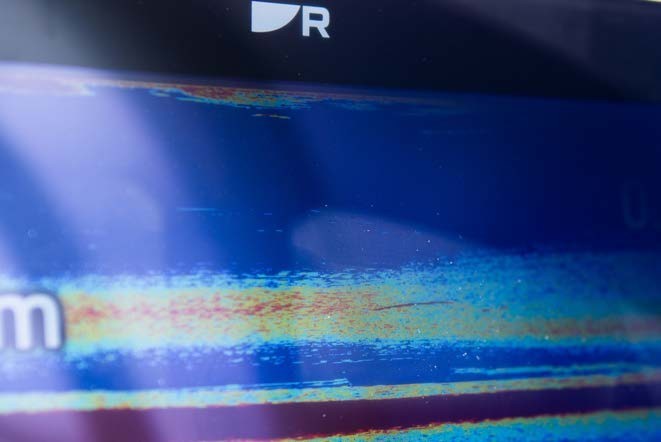
“ …a good fishfinder will differentiate the trout from the smelt schools. ”
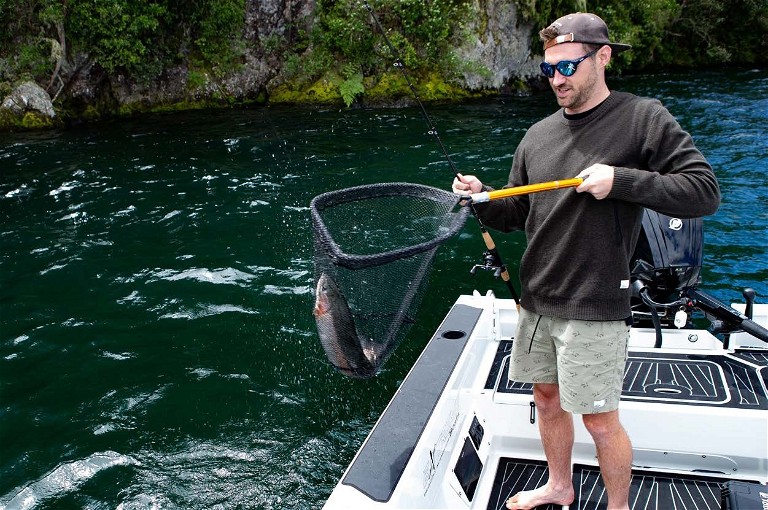
“ A longer rod comes in handy as by the time my rig is tied it is around three metres long and if you get a fish on the bottom fly when using a short rod, it can be a mission to get the fish in the net. ”
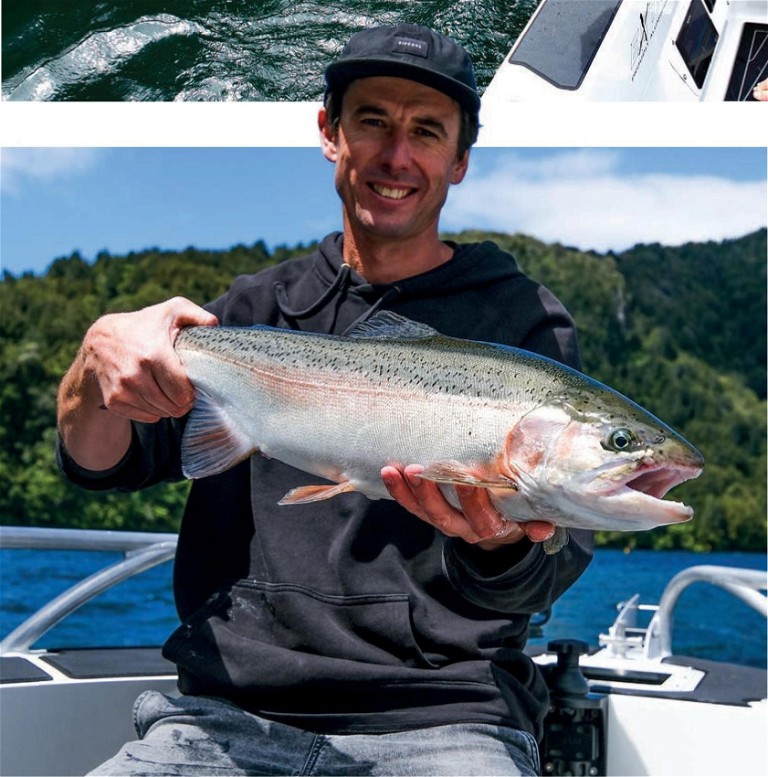
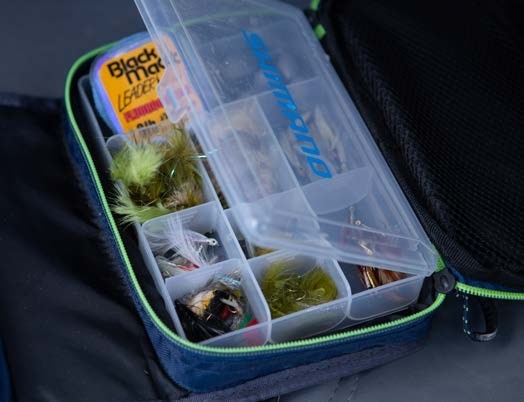
The gear
There is an overwhelming selection of rods and reels on the market but two things I find are beneficial are a longer rod and a reel that has a good retrieve ratio. A longer rod comes in handy as by the time my rig is tied it is around three metres long and if you get a fish on the bottom fly when using a short rod, it can be a mission to get the fish in the net. I like to use reels with a good retrieve ratio as a lot of the time trout will shoot toward the surface once hooked, and if you cannot keep up and the line goes slack they can shake the hook and happily swim away.
We often have our kids and their friends on the boat so usually run ‘eggbeater’ style reels as they are easy to use and can be wound up fast when required – thus many softbait setups will work fine. I fill the reels up with light braid as sometimes bites can be subtle, and the braid will let you feel even the slightest tap from a customer biting out of curiosity more than hunger. Two bits of gear on your boat that will certainly help your success while jigging are good electronics and an electric trolling motor to hold you on top of the fish as they can hold in tight areas at times.
The rig
All sorts of rigs will work well including some awesome pre-tied rigs by Pat Swift, but the following seems to work for me. My go-to trace is 8lb fluorocarbon in the super clear lakes such as Okataina, and in the darker lakes or those I know hold bigger fish I will often run 10lb. At the top end I tie the smallest swivel I can to connect the braid to the fluorocarbon and this will allow the swivel to be wound carefully through the eyes of the rod tip when netting fish. Around 30cm below that I tie the first dropper which is made by cutting the trace there, then reconnecting it by tying two back-to-back uni knots, leaving the top tag end around 10cm long which will become the top dropper to tie a fly. It is important to leave the top tag end as your dropper, as it will splay out nicely and not twist around the trace like it would if the bottom tag end were to be your dropper. I repeat this two more times with each dropper just under a metre apart, making a three-dropper rig with a 2oz tear drop sinker tied to the bottom.
The flies

Different flies will work well on different lakes, but I always try to tie a larger/darker fly at the bottom, something with a bit of colour in the middle, and a small, light-coloured smelt fly on the top. To me, this is how the food sources will be positioned in the lakes with the larger, darker-coloured bullies and freshwater crayfish near the bottom, and the smelt higher in the water column. Often the top smelt flies pick up more trout, but the darker bottom fly will pick up the larger fish. I have found the smaller epoxy-eyed jack sprats, or grey ghosts, are great flies to tie on the top dropper, a red bunny or ginger mick on the middle dropper, and a black or green wooly bugger on the bottom dropper – this seems to work well on most lakes. It is always worthwhile calling into a local tackle store to chat with the guys who are spending plenty of time on the lakes – they will point you in the right direction.
The technique
The technique is super straightforward – in fact, plenty of people hook fish jigging with their rods sitting in the rod holder as the boat movement does the job for them. A small lift of the rod tip is all that is required every few seconds to make the flies look lifelike and natural, and if you get a bit too vigorous with the jigging movements the flies will start to look unnatural. If the bait is thick and you are marking trout in various depths, it does pay to work that column of water by winding the handle after each lift of the rod tip and lowering the rig back down once you think you are just above the smelt line.
When marking fish near the bottom I like to bounce my rig a little on the bottom, stirring up the mud or weed a little, as this can bring the trout in for a closer look to find a feed that may have been disturbed from its shelter. Most of the time the bite will be pretty solid and the hookups will happen themselves, but when they are not feeding well at times you have to be a bit more on to it and strike at a subtle bite to sink the hook.
“ You do not have to be stealthy when it comes to jigging, and we often have our kids swimming while hooking fish below and they can make as much noise on the boat as they like (which is a fair bit) without spooking fish. ”
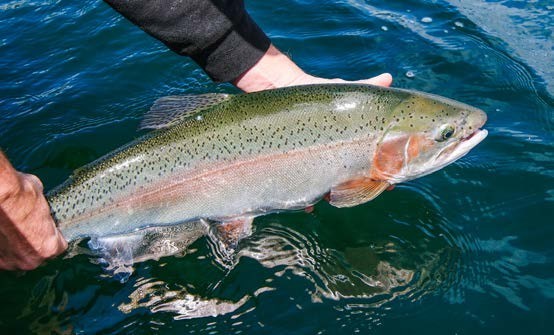
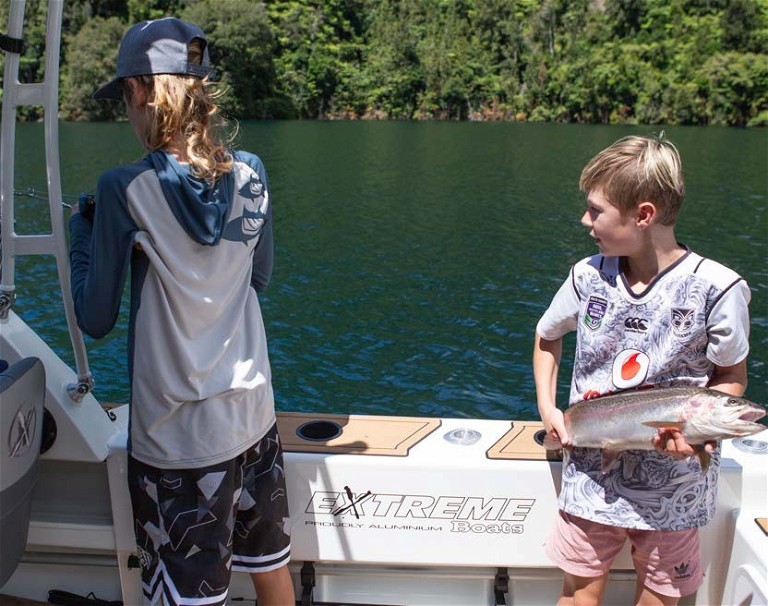

“ Jigging can be an awesome way to introduce newbies or young ones to fishing due to the simple technique required. ”
Fun for everyone
Jigging can be an awesome way to introduce newbies or young ones to fishing due to the simple technique required. You do not have to be stealthy when it comes to jigging, and we often have our kids swimming while hooking fish below and they can make as much noise on the boat as they like (which is a fair bit) without spooking fish. Next time you cannot get out to sea due to rough conditions, tow the boat to a lake and give it a crack. It’s a super peaceful place to be, your boat will thank you for giving it a decent bath – and you may also find yourself having one heck of a fun session jigging in the jungle.